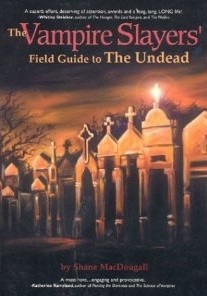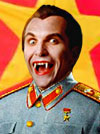|
MENU
Home
Books
Horror Film Aesthetics
Horror Film Festivals and Awards
Vampire
Nation
Pentagon Possessed
Cost of Freedom
Manhattan
Sharks
Halloween
Candy
Hollywood
Witches
Short Works
Pursuits
Actor
Film Festival Director
Editorial Services
Media
Appearances
Horror Film Reviews
Blogs
Horror Film Aesthetics
Communist Vampires
Horror Film Festivals and Awards
Other
Business
Satire
Nicolae Ceausescu
Commuist Vampires
Stalinist Zombies
L'Internationale Song
Links

|
 Author
Shane MacDougall says that many of today's popular beliefs about
vampires (their habits, strengths, and weaknesses) derive from
films and modern novels, and bear only tenuous relation to ancient
vampire myths and folklore. Author
Shane MacDougall says that many of today's popular beliefs about
vampires (their habits, strengths, and weaknesses) derive from
films and modern novels, and bear only tenuous relation to ancient
vampire myths and folklore.
For instance, he says that the Chinese Chiang-Shih is that rare
vampire affected by garlic, mirrors, running water, and
shapeshifting; most vampires aren't. Furthermore, vampire folklore
varies widely throughout the world, at least if one defines
vampire broadly, which MacDougall does. Psychic vampires qualify.
Much of the book is arranged by nations, making it easy to look up
each country's vampire folklore. Not every nation on Earth, but
it's an extensive and diverse listing, with entries from six
continents (Antarctic appears to be Earth's only vampire-free
continent!). Thankfully, this means the often overlooked Africa
and South America are included.
Yet while this book is a useful reference tool, it can't seem to
decide whether it wants to be a reference tool or pop
entertainment. Amid obscure and scholarly data are padding and
fluff. Some entries are scant; a page or two -- and that includes
illustrations (19 artists are credited). But while some
illustrations are helpful or compelling, others are silly and
irrelevant (such as photographs of campy women wearing fangs or
carrying stakes). It's padding and fluff, and at 686 pages, this
book doesn't need it.
The sequence of chapters also seems calculated for a breezy read.
The nationality chapters are interspersed between more general
chapters. "A World of Vampire A-F" (Albania to France) is
followed by "Becoming Undead," then "A World of
Vampires G-L," then "Fighting the Undead," etc.
Sometimes irrelevant sidebars pepper the chapters.
A sidebar on "Sirens" appears with the "Vampires of
France" (why not with the "Vampires of Greece"?).
The "Vampires of Byelorus" has sidebars on "Telepathy"
and "Werewolves In Movies." (Even if Byelorusian
mjertovjecs are shapeshifters, what have they to do with
I Was A Teenage Werewolf?)
Nothing wrong with irrelevant sidebars in a book intended to be
read sequentially, but less appropriate for a reference tool.
Yet despite the fluff and casual arrangement,
The Vampire Slayer's Guide is a useful reference tool. The
meat is scholarly and impressive, although as with any such
extensive work, one can always nitpick.
In "Vampires of Transylvania," MacDougall writes:
"During the time of Vlad Tepes, Romania's ruling class was
composed of Romanian Szekelys and Hungarian Magyars."
However, my father, who is a Szekeyly and born in Transylvania,
insists the Szekelys are Magyars, albeit a subgroup, and in no way
Romanian. (And as Magyar is Hungarian for Hungarian,
"Hungarian Magyar" would be redundant).
Elsewhere, MacDougall writes: "Tangled in the complex rural
histories of Romania and other Slavic countries are a number of
references to different types of Strigoi." However, Romanians
have long insisted that they are not Slavic, but a Latin people,
descended from Roman colonists (hence, Romanian).
No small point. Ethnic issues in Eastern Europe remain contentious
and politically pregnant. The late Romanian dictator
Nicolae Ceausescu, in seeking
Western aid, would stress that Romania is "a Latin island in a
Slavic sea."
I know less about the other nationalities in the book, and thus
can't comment on it. I can comment on MacDougall's use of
"revenant," which he defines as: "A corpse that has been
reanimated and has risen as a vampire, ghost, zombie, or angel.
For the purposes of this book, Revenant will be used as a term to
describe those vampires that are human corpses that have returned
from the dead. These vampires are often pale and shambling, their
bodies showing signs of decay."
It's no biggie, but I define a revenant as a corpse with a degree
of self-awareness and intent (usually revenge, as often seen in
Tales From the Crypt). By contrast, a zombie lacks
self-awareness and is usually under another's control (e.g.,
White Zombie, I Walked With a Zombie),
or is of the often mindless, flesh-eating variety. Unlike
MacDougall, I don't equate revenants with vampires. But then, we
use the term for different purposes. Like I said, no biggie.
An oddity: The book prominently announces that Shawn MacDougall is
the pen name of Jonathan Maberry. Likewise, the book's promotional
material. Sort of defeats the whole point of having a pen name,
no?
Another oddity: MacDougall prefers C.E. to the "formerly" A.D.
(Not so formerly, as most Americans still use A.D.) But then
MacDougall defines C.E. as "Christian Era" rather than its "Common
Era." I've seen both, but the former, again, sort of defeats the
purpose, no? (And since we still name our days and months after
pagan gods, why are Christian cultural references offensive?)
Additionally, he uses both B.C. and B.C.E., alternating between
the two in the same sidebar.
Oddities aside, MacDougall does a fine job gathering vampire
folklore from around the world, compiling their names and
characteristics, along with tales and legends for many of them.
The illustrations are attractive, if not always pertinent. All
black & white, aside from a 14-page "Color Gallery." 540 pages of
main text, plus 132 pages of appendixes covering vampire websites,
unset groups, bibliographies, filmographies, glossary, etc.

|



 Author
Shane MacDougall says that many of today's popular beliefs about
vampires (their habits, strengths, and weaknesses) derive from
films and modern novels, and bear only tenuous relation to ancient
vampire myths and folklore.
Author
Shane MacDougall says that many of today's popular beliefs about
vampires (their habits, strengths, and weaknesses) derive from
films and modern novels, and bear only tenuous relation to ancient
vampire myths and folklore.